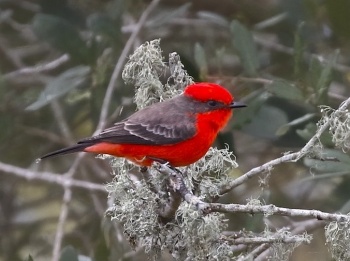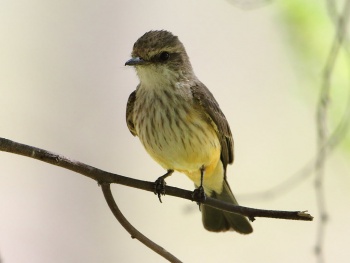(Picture placement due to edit issues) |
Nutcracker (talk | contribs) (format) |
||
| Line 1: | Line 1: | ||
| − | [[Image:Vermilion_Flycatcher.jpg|thumb|550px|right| | + | [[Image:Vermilion_Flycatcher.jpg|thumb|550px|right|''P. r. piurae'', female to the left, male to the right<br />Photo by {{user|mmdnje|mmdnje}}<br />Ayampe, Manabi Prov, [[Ecuador]].]] |
;[[:Category:Pyrocephalus|Pyrocephalus]] rubinus | ;[[:Category:Pyrocephalus|Pyrocephalus]] rubinus | ||
'''Includes: Scarlet Flycatcher, Darwin's Flycatcher, San Cristobal Flycatcher''' | '''Includes: Scarlet Flycatcher, Darwin's Flycatcher, San Cristobal Flycatcher''' | ||
==Identification== | ==Identification== | ||
| − | [[Image:Vermilion Flycatcher male Anahuac NWR.jpg|thumb|350px|right| | + | [[Image:Vermilion Flycatcher male Anahuac NWR.jpg|thumb|350px|right|''P. r. flammeus'', male<br />Photo by {{user|Stanley+Jones|Stanley Jones}}<br />[[Anahuac National Wildlife Refuge]], Chambers County, [[Texas]], [[USA]], October 2017]] |
L. 14 cm (5½ in)<br /> | L. 14 cm (5½ in)<br /> | ||
| Line 16: | Line 16: | ||
Females from [[Galapagos]] have virtually unstreaked, yellow underparts. | Females from [[Galapagos]] have virtually unstreaked, yellow underparts. | ||
| − | Both sexes of race ''obscurus'' (from coastal [[Peru]]) also occur in a uniformly dark brown morph. | + | Both sexes of race ''P. r. obscurus'' (from coastal [[Peru]]) also occur in a uniformly dark brown morph. |
====Similar Species==== | ====Similar Species==== | ||
| − | [[Image:616 06388fg First Year Vermilion Flycatcher.jpg|thumb|350px|right| | + | [[Image:616 06388fg First Year Vermilion Flycatcher.jpg|thumb|350px|right|''P. r. flammeus'', juvenile<br />Photo by {{user|bobsofpa|bobsofpa}}<br />Cottonwood Campground, [[Big Bend National Park]], [[Texas]], [[USA]], April 2016]] |
Females and immatures are potentially confusing, but can be separated from most other superficially similar species (e.g. [[Bran-colored Flycatcher]]) by the faint or complete lack of wing-bars. | Females and immatures are potentially confusing, but can be separated from most other superficially similar species (e.g. [[Bran-colored Flycatcher]]) by the faint or complete lack of wing-bars. | ||
==Distribution== | ==Distribution== | ||
| Line 29: | Line 29: | ||
Around 13 subspecies are generally recognised<sup>[[#References|[1]]]</sup>:<br /> | Around 13 subspecies are generally recognised<sup>[[#References|[1]]]</sup>:<br /> | ||
'''Rubinus Group'''<br /> | '''Rubinus Group'''<br /> | ||
| − | *P. r. flammeus'': Arid south-western [[US]] to [[Baja California]] and north-western [[Mexico]] (Nayarit) | + | *''P. r. flammeus'': Arid south-western [[US]] to [[Baja California]] and north-western [[Mexico]] (Nayarit) |
| − | *P. r. mexicanus'': Arid south-western [[Texas]] to Guerrero, Oaxaca, Puebla and Veracruz | + | *''P. r. mexicanus'': Arid south-western [[Texas]] to Guerrero, Oaxaca, Puebla and Veracruz |
| − | *P. r. blatteus'': South-eastern [[Mexico]] (southern Veracruz) to [[Guatemala]] and [[Honduras]] | + | *''P. r. blatteus'': South-eastern [[Mexico]] (southern Veracruz) to [[Guatemala]] and [[Honduras]] |
| − | *P. r. pinicola'': Lowland pine savanna of north-eastern [[Nicaragua]] | + | *''P. r. pinicola'': Lowland pine savanna of north-eastern [[Nicaragua]] |
| − | *P. r. saturatus'': North-eastern [[Colombia]] to northern [[Venezuela]], [[Guyana]] and northern [[Brazil]] | + | *''P. r. saturatus'': North-eastern [[Colombia]] to northern [[Venezuela]], [[Guyana]] and northern [[Brazil]] |
| − | *P. r. piurae'': [[Colombia]] (west of Eastern Andes) to westelrn [[Ecuador]] and north-western [[Peru]] | + | *''P. r. piurae'': [[Colombia]] (west of Eastern Andes) to westelrn [[Ecuador]] and north-western [[Peru]] |
| − | *P. r. ardens'': Northern [[Peru]] (Cajamarca, Amazonas and extreme eastern Piura) | + | *''P. r. ardens'': Northern [[Peru]] (Cajamarca, Amazonas and extreme eastern Piura) |
| − | *P. r. obscurus'': Western [[Peru]] (Lima) | + | *''P. r. obscurus'': Western [[Peru]] (Lima) |
| − | *P. r. cocachacrae'': South-western [[Peru]] (Ica to Tacna) and adjacent northern [[Chile]] | + | *''P. r. cocachacrae'': South-western [[Peru]] (Ica to Tacna) and adjacent northern [[Chile]] |
| − | *P. r. major'': South-eastern [[Peru]] (Cuzco and Puno) | + | *''P. r. major'': South-eastern [[Peru]] (Cuzco and Puno) |
| − | *P. r. rubinus'': Extreme south-eastern [[Brazil]] to south-eastern [[Bolivia]], [[Paraguay]], [[Uruguay]], north-eastern [[Argentina]] | + | *''P. r. rubinus'': Extreme south-eastern [[Brazil]] to south-eastern [[Bolivia]], [[Paraguay]], [[Uruguay]], north-eastern [[Argentina]] |
'''Galapagos Group'''<br /> | '''Galapagos Group'''<br /> | ||
| − | *P. r. nanus'': [[Galapagos Islands]] (except Chatham Island) | + | *''P. r. nanus'': [[Galapagos Islands]] (except Chatham Island) |
| − | *P. r. dubius'': [[Chatham Island]] (Galapagos Islands), extinct | + | *''P. r. dubius'': [[Chatham Island]] (Galapagos Islands), extinct |
| − | It has been suggested that the two Galapagos | + | It has been suggested that the two Galapagos subspecies ''P. r. nanus'' and ''P. r. dubius'' should be considered one or two separate species. IOC have now split those two as '''Darwin's Flycatcher''' and '''San Cristobal Flycatcher''' (already extinct). Further, they have also split ''P. r. rubinus'' as '''Scarlet Flycatcher''', leaving the rest of the species as Vermilion Flycatcher ''Pyrocephalus obscurus''<sup>[[#References|[2]]]</sup>. |
==Habitat== | ==Habitat== | ||
Occurs in a wide range of open or semi-open habitats, including savanna, forest-edge, woodland, scrub, areas with scattered trees. Also in rural zones and city parks or gardens. | Occurs in a wide range of open or semi-open habitats, including savanna, forest-edge, woodland, scrub, areas with scattered trees. Also in rural zones and city parks or gardens. | ||
| Line 60: | Line 60: | ||
{{GSearch|Pyrocephalus+rubinus}} | {{GSearch|Pyrocephalus+rubinus}} | ||
<br /> | <br /> | ||
| − | This link searches for videos | + | This link searches for videos of Vermilion Flycatcher |
| − | {{Video| | + | {{Video|Vermilion Flycatcher}} |
[[Category:Birds]] [[Category:Pyrocephalus]] [[Category:Videos]] | [[Category:Birds]] [[Category:Pyrocephalus]] [[Category:Videos]] | ||
Revision as of 16:23, 22 December 2017
- Pyrocephalus rubinus
Includes: Scarlet Flycatcher, Darwin's Flycatcher, San Cristobal Flycatcher
Identification

Photo by Stanley Jones
Anahuac National Wildlife Refuge, Chambers County, Texas, USA, October 2017
L. 14 cm (5½ in)
Strongly sexually dimorphic. Male is unmistakable.
Male: Bright red underparts and cap, dark brownish wings, tail and mask.
Female: Dull brownish or greyish upperparts, dark streaked whitish underparts. In some subspecies they have pinkish or yellow flanks and/or crissum.
Immature: resembles female but if female has reddish-pink lower belly and crissum, then the first year bird will often have more yellowish or salmon wash.
Variation
Females from Galapagos have virtually unstreaked, yellow underparts.
Both sexes of race P. r. obscurus (from coastal Peru) also occur in a uniformly dark brown morph.
Similar Species

Photo by bobsofpa
Cottonwood Campground, Big Bend National Park, Texas, USA, April 2016
Females and immatures are potentially confusing, but can be separated from most other superficially similar species (e.g. Bran-colored Flycatcher) by the faint or complete lack of wing-bars.
Distribution
It is widespread and generally common in most of central and northern South America, Central America, Mexico and southwestern United States.
Typically resident, but a large proportion of the population from the southernmost part of its range migrate north to spend the Austral winter in central South America. Additionally, most of the population in USA migrate south to spend the winter in Central America.
Taxonomy
Subspecies
Around 13 subspecies are generally recognised[1]:
Rubinus Group
- P. r. flammeus: Arid south-western US to Baja California and north-western Mexico (Nayarit)
- P. r. mexicanus: Arid south-western Texas to Guerrero, Oaxaca, Puebla and Veracruz
- P. r. blatteus: South-eastern Mexico (southern Veracruz) to Guatemala and Honduras
- P. r. pinicola: Lowland pine savanna of north-eastern Nicaragua
- P. r. saturatus: North-eastern Colombia to northern Venezuela, Guyana and northern Brazil
- P. r. piurae: Colombia (west of Eastern Andes) to westelrn Ecuador and north-western Peru
- P. r. ardens: Northern Peru (Cajamarca, Amazonas and extreme eastern Piura)
- P. r. obscurus: Western Peru (Lima)
- P. r. cocachacrae: South-western Peru (Ica to Tacna) and adjacent northern Chile
- P. r. major: South-eastern Peru (Cuzco and Puno)
- P. r. rubinus: Extreme south-eastern Brazil to south-eastern Bolivia, Paraguay, Uruguay, north-eastern Argentina
Galapagos Group
- P. r. nanus: Galapagos Islands (except Chatham Island)
- P. r. dubius: Chatham Island (Galapagos Islands), extinct
It has been suggested that the two Galapagos subspecies P. r. nanus and P. r. dubius should be considered one or two separate species. IOC have now split those two as Darwin's Flycatcher and San Cristobal Flycatcher (already extinct). Further, they have also split P. r. rubinus as Scarlet Flycatcher, leaving the rest of the species as Vermilion Flycatcher Pyrocephalus obscurus[2].
Habitat
Occurs in a wide range of open or semi-open habitats, including savanna, forest-edge, woodland, scrub, areas with scattered trees. Also in rural zones and city parks or gardens.
Behaviour
Diet
Feeds on small insects and spiders. It perches on an open branch, waiting for the prey. After locating it, the flycatcher pursues and captures it in flight.
Breeding
The courtship display of the male involves singing, raising its crest, fluffing its breast-feathers and, sometimes, delivering a butterfly or showy insect to the female to initiate copulation.
Breeding is seasonal, but timing varies depending on region. The nest is an open cup loosely constructed by moss, grass, twigs and spiderwebs. The 2-3 eggs are incubated entirely by the female, but both sexes feed the chicks.
References
- Clements, J. F., T. S. Schulenberg, M. J. Iliff, D. Roberson, T. A. Fredericks, B. L. Sullivan, and C. L. Wood. 2017. The eBird/Clements checklist of birds of the world: v2017, with updates to August 2017. Downloaded from http://www.birds.cornell.edu/clementschecklist/download/
- Gill, F and D Donsker (Eds). 2017. IOC World Bird Names (version 7.1). Available at http://www.worldbirdnames.org/.
Recommended Citation
- BirdForum Opus contributors. (2024) Vermilion Flycatcher. In: BirdForum, the forum for wild birds and birding. Retrieved 30 April 2024 from https://www.birdforum.net/opus/Vermilion_Flycatcher
External Links
This link searches for videos of Vermilion Flycatcher





